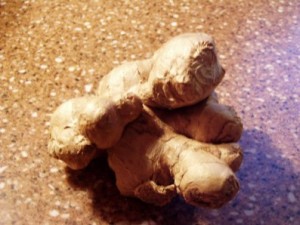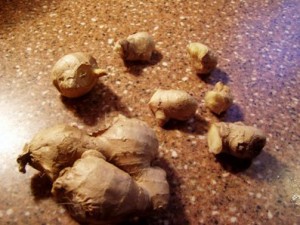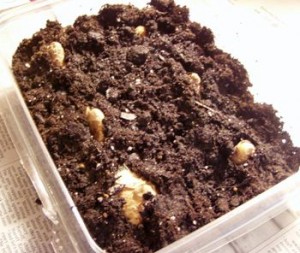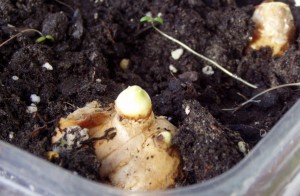 Gingerbread. Ginger Snaps. Ginger Tea. Asian dishes with ginger. Candied Ginger as a confection. A thousand and one uses of this member of the Zingeberaceae family (which also includes turmeric, cardamom, and Galangal, which is also referred to as ‘Thai Ginger’). It smells good and tastes…well, until you put in enough to make the dish ‘hot’, it tastes amazing.
Gingerbread. Ginger Snaps. Ginger Tea. Asian dishes with ginger. Candied Ginger as a confection. A thousand and one uses of this member of the Zingeberaceae family (which also includes turmeric, cardamom, and Galangal, which is also referred to as ‘Thai Ginger’). It smells good and tastes…well, until you put in enough to make the dish ‘hot’, it tastes amazing.
A few factoids:
1. Ginger was the very first spice from the East to be grown in the West. Ginger was introduced into Jamaica in 1585 to be grown and imported back to Europe.
2. India is the number one producer of ginger, growing over 380,000 tonnes in 2008.
3. The characteristic smell that we associate with ginger comes from mixture of zingerone, shogaols and gingerols, which are volatile oils and which can make up to 3% of the total weight of the rhizome.
4. Since so much attention is spent in Asian folk medicine to the use of ginger in various ailments, quite a bit of research has been done to the benefits of consuming it to treat everything from constipation to inflammatory diseases. Concurrently, science is paying just as much attention to ginger’s cousin, turmeric. Since both of these spices can be combined in curry dishes, eating Indian food can give consumers a double dose.
The ginger we buy in the fresh produce part of the grocery store looks like the photo at the top and is referred to (for obvious reasons) as ‘a hand’. It is a rhizome (other rhizomes you might be familiar with are German irises and cannas; potatoes are NOT rhizomes but are tubers and we will discuss that at another time) and it is this form of vegetative reproduction that makes it something that we, too, can grow at home (even here at Chez Siberia, as I will show you). Now, if you don’t want to do this with ‘store bought’ ginger, you can search on the internet for a domestic grower such as East Branch Ginger. I signed up for their newsletter so that I will not miss out when they start taking orders for 2013.
BUT, this is something you really can grow from something at the grocery store and here is how to do it:
First: Look for a hand with lots of little knobs on the fingers. These are what will end up sprouting. Make sure the fingers are firm and the skim is not wrinkly (that means it is drying out and I feel you won’t have as much luck sprouting them).
 Second: Cut up the fingers into pieces, making sure you have little knobs on each finger. This is sort of like cutting up seed potatoes.
Second: Cut up the fingers into pieces, making sure you have little knobs on each finger. This is sort of like cutting up seed potatoes.
Third: Place the seed ginger pieces into a shallow container with growing mix that you can keep covered, moist and warm. Ginger will not sprout with soil temperatures lower than 55 degrees F so you might need to provide bottom heat for it. Optimal sprouting temperatures are, according to East Branch Ginger, 75-80 degrees F. I have an electric seed starting mat with a metal grid over the top, so I used that out in our unheated greenhouse. I literally used one of those plastic smaller bulk salad mix containers with a snap on lid that I get at the grocery store. Those are very useful for starting seeds because they literally are their own little greenhouses and once the seeds come up, you can just take off the lids.
Now, this is the first time I have done this (I have since found out from East Branch’s very informative newsletters that I pretty much did the right thing with this), so I had no idea how long it would take for the pieces to start sprouting. Even with bottom heat and light from the windows, it has taken a couple of weeks for the seed pieces to start sprouting. It’s also (and this is the same for other rhizome sprouting too) important that you don’t overwater the soil mix (it also helps if you don’t use growing mixes that are mucky; airy and well-drained are two good watchwords here) because it will make the rhizomes rot.
 So, here we are several weeks later. The knobs have just started to sprout. It will be interesting to see how this goes. I’m very excited to see if we can get these to grow and reproduce into big ginger ‘hands’. I’m thinking that putting them into a growing situation like the ones I use for peppers might be the trick since are a tropical plant and need warm soil temperatures.
So, here we are several weeks later. The knobs have just started to sprout. It will be interesting to see how this goes. I’m very excited to see if we can get these to grow and reproduce into big ginger ‘hands’. I’m thinking that putting them into a growing situation like the ones I use for peppers might be the trick since are a tropical plant and need warm soil temperatures.
Just a note – for folks who grow the ground cover called ‘wild ginger’ or ‘Canadian ginger’ – this is not a member of the same family and thought the roots smell much the same, it contains compounds which are known carcinogens so eating them would not be a good idea. Stick with what you get in the produce section of the grocery store or from a reputable grower.

I have a variety known as Roscoe and I’m wondering if it’s edible. It makes beautiful, waxy orchid-like flowers.
Lindy – you might want to read this; perhaps this will answer your question. http://www.herbsnspicesinfo.com/spices/ginger.aspx